Midwinter Masking Place and Identity in an Ironworks Community
Keywords:
carnival, external monitoring, masks, midwinter festivity, St Knut, SwedenAbstract
In the dead of winter on January 13th each year, an evening masking festival takes place in Gimo, a small rural ironwork community
situated in the district of Uppland in central Sweden. No one knows for certain how old this festival, which on the calendar day of St Knut marks the end of Christmas season, is, but one of the main functions of the festivity nowadays is the opportunity for the population of Gimo to reconnect with friends and neighbours. This is done both while preparing for the main event on January 13th and on the evening of that date when everyone reveals what they secretly have been working on for this year’s festivity.
The traditional division of labour between the sexes during the preparations (for Swedish urban standards surprisingly) results in an exchange of work occurring; reaffirming ties between men and women,
and of family and friendship within the community.
The main inspiration for dressing up is current events, and the choice of masking can be seen as a form of external monitoring, functioning both as individual expressions and statements of the community as a unity, illustrating political views, humour, and fears. The research examples in this paper come from the fieldwork carried out during the winter seasons of 2012/2013—2014/2015 in three small rural ironwork communities in the district of Uppland in Sweden: Gimo, Österbybruk and Östhammar. The importance of the masking tradition is especially apparent in Gimo, which will be the main focus in this paper.
Downloads
Published
Issue
Section
License

This work is licensed under a Creative Commons Attribution-NonCommercial-NoDerivatives 4.0 International License.

